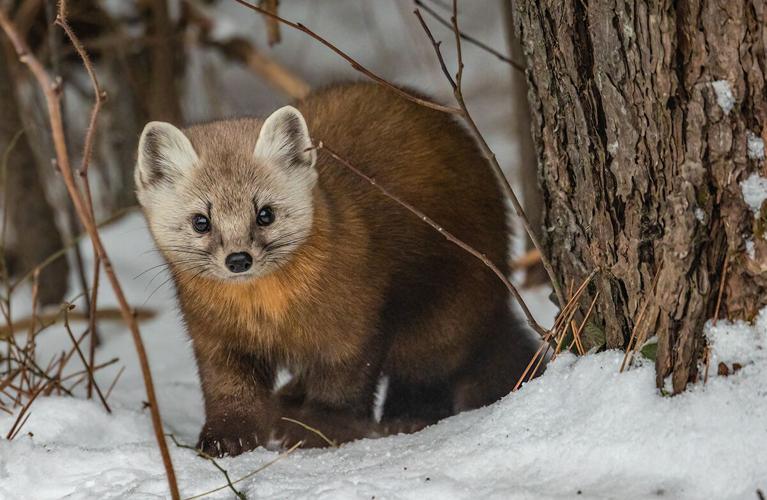The American marten, a furry cat-size predator and symbol of wilderness that has long been gone from Pennsylvania’s deep forests, may return.
The Pennsylvania Game Commission has given staff the green light to prepare a reintroduction and management plan as the first step to repopulating the big woods in the northern part of the state with the member of the weasel family. A vote by game commissioners to proceed with the release of martens into state forest and game lands may occur in September 2023.

A plan is in the works to return American martens, a member of the weasel family, to the vast forests of northern Pennsylvania. (Allison Gregor)
Fossils show that American martens, sometimes called pine martens, once occupied other states in the Chesapeake Bay drainage, such as Maryland, Virginia and West Virginia. But they were extirpated in those states, largely by the turn of the 20th century, by trapping, hunting, logging and development. Their dark fur was once second only to beavers in the fur trade.
The solitary martens have managed to remain established, though, in New York’s Adirondacks region, other northern states and Canada.
Nearly two decades ago, Pennsylvania’s wildlife managers considered reintroducing martens but said not enough was known about whether the state still had enough mature, contiguous forests for suitable habitat. There also were concerns about whether the predator would consume prize game like turkey and grouse.
With technological advances in satellite imagery, remote-sensing Lidar and geographic information systems, a 42-page feasibility study released by agency staff in July concludes that parts of Pennsylvania would indeed support martens.
“American marten reintroduction to Pennsylvania is likely to succeed and should be considered as the next step in a long history of restorative conservation efforts within the commonwealth,” the study concludes.
Weighing 1 to 3 pounds, martens are anywhere from 19 to 27 inches long, from nose to tip of tail. They sport dense brownish-black hair and have large feet to aid them in traversing snow, as well as short legs to crawl into crevices and tree cavities.
Martens have a penchant for hunting and traveling in treetops of mature deciduous and conifer woods, where they build their dens in tree cavities. They will also rummage for prey under snow and downed logs.
The vast forested mountains of northern Pennsylvania, with large tracts of state forests, could provide just that, according to the study. It was once thought martens needed exclusively dense conifer forests, but researchers discovered they thrive in old mixed forests as well.

Snow and large mature forests are critical habitat for American martens. (Allison Gregor)
The targeted Pennsylvania forests also have a varied understory, important for foraging and resting, researchers found.
As for trepidation among hunters that martens would ambush their favorite game animals, extensive diet surveys in multiple northeastern states reveal 68% of their diet consists of voles, mice, shrews and other small mammals that inhabit forests. And research by the Western Pennsylvania Conservancy shows such rodents are plentiful in the potential home range.
Besides rodents, martens supplement their diet with insects, plants, carrion, fish, amphibians, reptiles and occasionally other martens. Game birds like grouse and turkeys were not found in the diet studies, nor were their eggs.
Martens are perfectly willing to be scavengers, so resource managers say the thousands of deer carcasses left by hunters will help feed them. Martens also have an appetite for plants and berries, so their droppings may help disperse native plants throughout the forest.
Snow is important to martens’ survival as a means of hiding from larger predators such as bobcats, coyotes and weasels. (Fishers, another member of the weasel family, is a fairly recent reintroduction success story in the state). Snow also is where most rodents can be found in winter.
Though researchers acknowledge that less snow is expected for much of Pennsylvania in future years because of climate change, the areas targeted for marten habitat receive lake-effect snow from the Great Lakes.
Martens released in Pennsylvania would likely come from Canada and such states as New York, Maine, Vermont, Wisconsin, Michigan and New Hampshire. Genetic diversity is important to establishing a healthy new Pennsylvania population.
Why bring back martens at all?
Tom Keller, the Game Commission’s furbearer biologist, can cite some reasons.
One is that they were long part of a vibrant, interconnected forest ecosystem. “When we have martens, we know we have a healthy forest,” he said. Forest habitat managed to suit martens will also aid lesser-known wildlife that depends on similar mature, contiguous forests, he added.
Then there is the notion that martens deserve to be brought back because they are native to the state and can still thrive there, if given the chance. A survey of 1,047 people, including hunters, by a Penn State research team found a that 92% favored reintroduction.


(0) comments
Welcome to the discussion.
Log In
We aim to provide a forum for fair and open dialogue.
Please use language that is accurate and respectful.
Comments may not include:
* Insults, verbal attacks or degrading statements
* Explicit or vulgar language
* Information that violates a person's right to privacy
* Advertising or solicitations
* Misrepresentation of your identity or affiliation
* Incorrect, fraudulent or misleading content
* Spam or comments that do not pertain to the posted article
We reserve the right to edit or decline comments that do follow these guidelines.